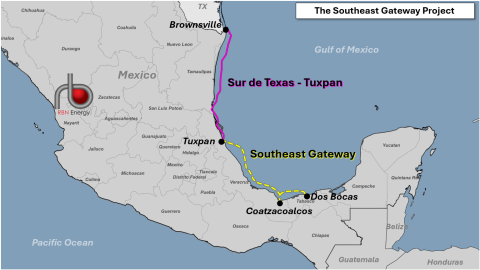A significant shift is underway within Mexico’s energy landscape, reflected by the development of large-scale oil and gas infrastructure projects in the country, particularly the Southeast Gateway and Sierra Madre gas pipelines that would move U.S.-sourced natural gas across Mexico. These projects — the first an undersea pipe in the Gulf of Mexico and the second a pipe across the country’s northern tier — would enhance Mexico’s gas transport capacity while supporting power generation and industrial development. Mexico, which is already heavily reliant on imports of U.S. gas, is forecast to see gas demand rise in the coming years as domestic production drops. In today’s RBN blog, we look at those two pipelines, their challenges, and how the potential for U.S. tariffs on Mexican imports might complicate the future of both projects.
The Southeast Gateway Pipeline (dashed yellow line in Figure 1 below), also known as Gasoducto Puerta al Sureste, is a $3.9 billion (79 billion Mexican Peso) project led by TC Energy in partnership with Mexico’s state-owned Comisión Federal de Electricidad (CFE) that is slated to come online in May. (Allseas, a U.S. contractor, said in January that it had completed laying the offshore sections of the pipeline.) The conduit extends TC Energy’s existing 2.6-Bcf/d Sur de Texas-Tuxpan undersea pipeline (magenta line), which runs from Brownsville, TX, to Tuxpan. (As we noted in Southern Cross, Sur de Texas-Tuxpan connects with Enbridge’s Valley Crossing pipeline at the border. The gas for Southeast Gateway would be sourced from the Agua Dulce hub in South Texas.)

Figure 1. The Southeast Gateway Project. Source: RBN
The 444-mile (715-km), 1.3-Bcf/d undersea pipeline would link three key ports — Tuxpan and Coatzacoalcos in Veracruz state and Dos Bocas in Tabasco state. Its end users would likely include existing (about 240 MMcf/d) and future CFE power plants on Mexico’s Yucatán Peninsula that should begin service this year. (CFE, one of Mexico’s largest state-owned enterprises, provides transmission services and distributes electricity; generates and sells electricity; and imports, exports, transports, stores, purchases and sells natural gas, coal and other fuels. It also develops and executes engineering projects, research, and geological and geophysical activities; and oversees the development and implementation of energy sources.)
Join Backstage Pass to Read Full Article







